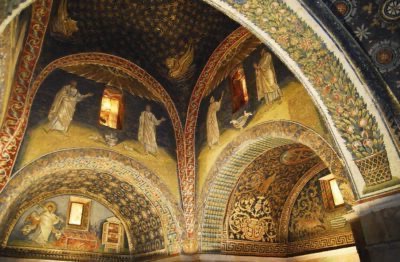A post about the city capable of capturing the gaze of the most distracted tourist, a place for all lovers of beauty and art.
Ravenna it is certainly there capital of mosaics and it is known worldwide for the works that attract art lovers and tourists like me. Strolling through its streets, where even the signs of the streets are made of mosaics, is an experience that totally immerses you in the beauty of art. Ravenna captures the gaze of the most distracted tourist.

Ravenna, a unique heritage
It contains the richest mosaic world heritage of the XNUMXth and XNUMXth centuries, evidence of the flourishing period of the Byzantine Empire, of which Ravenna was the capital. The technique used in the Byzantine period consisted in the juxtaposition of polychrome glass tesserae.
The city also retains 8 buildings declared World Heritage by Unesco, where among other things mosaics of unique beauty and importance are preserved.
Monuments of Ravenna
My itinerary followed the route recommended by the Opera di Religion of the Diocese of Ravenna, which guides you on a journey to discover the monuments of the XNUMXth and XNUMXth centuries. The ticket to visit 5 of Ravenna's treasures costs € 9,50 and is really worth them all. The ticket can be bought in one of the points of sale scattered around the streets of the center.
I started from the majestic Basilica of San Vitale, famous for its XNUMXth century mosaics and symbol of the Ravenna Archbishop's Chancellery. Famous are the two mosaics on the sides of the apse: the first is the Procession of Justinian, in which the emperor is placed in the center to dominate the scene, together with him in addition to the numerous soldiers are portrayed the bishop Maximian, Giuliano l'Argentario who financed the construction of the basilica and Belisarius, a Byzantine general who conquered Ravenna; on the other side there is the Procession of Theodora which depicts the imperial ceremonies in Ravenna presided over by the empress Theodora. Both mosaics are characterized by a gold-colored backdrop, this embellishes the figures and diffuses the light.
In the apse the Theophany is depicted, a divine manifestation: in the center is depicted Christ, between the Archangels Michael and Gabriel, who gives a crown to San Vitale, on one side is represented the bishop Ecclesio, founder of the church.
Leaving the Basilica you arrive at the Mausoleum of Galla Placidia: sister of Emperor Honorius, she moved the capital of the Western Roman Empire from Milan to Ravenna. The mausoleum was built but she died and was buried in Rome. The external simplicity of the construction hides the richness of the mosaic works that are discovered inside. Arches, lunettes and dome are entirely covered with mosaics.

The dome is the most famous part, covered with 570 gold stars against the blue sky background, representing the universe. At the corners there is the symbolism of the four evangelists, represented by bull, eagle, lion and man with wings. In the center appears the golden cross, symbol of God. In one of the lunettes the martyrdom of San Lorenzo is represented; in the lunettes of the drum the apostles are depicted, at the feet of which there are two doves near a fountain to symbolize the search for divine salvation. Doves are one of the most common mosaic symbols in Ravenna. Finally, above the entrance rises the Lunette of the Good Shepherd, one of the most famous mosaics in Ravenna.
Let's move on to Chapel of Sant'Andrea, where unfortunately I was unable to take pictures, you will still find many on the web. It was built during the reign of Theodoric. The chapel is preceded by a vestibule covered with marble in the lower part and mosaics in the upper one. Everything revolves around the figure of Christ depicted as a warrior who tramples the symbols of evil, the lion and the snake. What catches the eye is the depiction of a small duckling with one red and one black paw in a park. Unfortunately I do not know and have not found any reference to this particular scene.
Inside the sub-arches of the chapel are depicted the Martyrs, the Apostles and the Evangelists, a clear reference to Catholic orthodoxy in contrast with the Arian cult at the time of Theodoric.
Sant'Apollinare Nuovo it is the Basilica that represents the meeting between Arian and Christian doctrines.
Inside, the mosaic representations are divided into three parts, one superimposed on the other: the highest represents the life of Christ in rectangular squares; further down the thirty-two Prophets are depicted, in the lower part there is the procession of twenty-two saints led by Sant'Eufemia.

One of the oldest buildings is the Neonian Baptistery. With an octagonal plan, its upper part is entirely covered with glass tiles. The dome depicts the baptism of Christ inside a central medallion, around it the figures of the twelve apostles rotate. This image represents one of the oldest mosaics depicting the Savior's baptism. At the center of the baptistery there is a marble basin from the XNUMXth century and rebuilt in the XNUMXth century.
If you want to take home the symbols of this wealth, you will find all kinds of objects in bookstores and souvenir shops. You will remember the beauty of Ravenna's treasures every time.


























